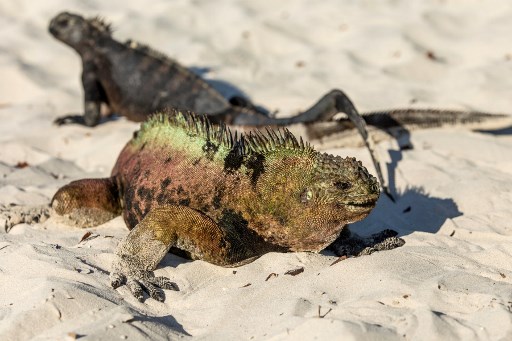
Ecuador’s growing tourism threatens the country’s fragile paradises. Galapagos islands declared a World Natural Heritage by UNESCO, limited tourism clashes with President Lenin Moreno’s “Cielos Abiertos”(Open Skies) policy to increase tourism and flight frequency all over the country, including the archipelago. / AFP PHOTO
QUITO, Ecuador (AFP) — Six land iguanas, endemic to the Galapagos Islands, have been relocated within the Pacific archipelago due to food shortages and overpopulation on the islet where they lived, Ecuador’s Galapagos National Park said Tuesday.
The reptiles were moved from the islet of Venice to Dragon Hill, on the neighboring island of Santa Cruz.
“The shortage of rain, little food and the high number of land iguanas on the islet of Venice” forced park authorities to transfer the reptiles of the species Conolophus subcristatus “to ensure the survival of individuals,” the park said in a statement.
The land iguanas, also known as yellow iguanas because of the color of their skin, originate from Dragon Hill.
In the 1970s part of the population was taken to Venice islet “to protect them from the presence of wild dogs that threatened their existence,” the park said.
Twenty years later, the park began a relocation process in which some “100 transfers” have been carried out, “particularly during times of drought or lack of food, while controls are carried out on predators” that threaten the fragile ecosystem, the park said.
The Galapagos, which inspired Charles Darwin’s theory of evolution, is located about 1,000 kilometers (600 miles) off the coast of the Ecuadoran mainland.
The national park, created in 1959, protects 97 percent of the islands’ land surface.
The Galapagos has an especially high concentration of endemic species, including giant tortoises and penguins. In 1978 UNESCO classified the islands as a World Heritage Site.
© Agence France-Presse







